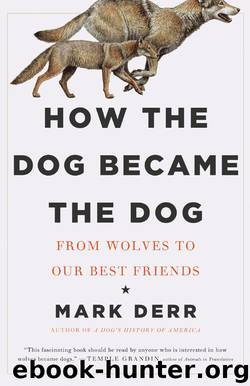How the Dog Became the Dog: From Wolves to Our Best Friends by Mark Derr

Author:Mark Derr [DERR, MARK]
Language: eng
Format: epub
Tags: PET004000, NAT044000, SCI027000
ISBN: 9781590209912
Publisher: The Overlook Press
Published: 2011-12-01T00:00:00+00:00
TWELVE
Why a Dog
Is Not a Wolf
So close together, yet so far apart. The human element
cannot be overlooked. People define dog—and wolf.
A signal problem in re-creating the evolution of the dog predates the advent of modern genetics: What physical changes clearly say this animal is a dog? Implicit in that question is the conviction that without physical changes there is no dog, only a socialized wolf. The debate over these matters might seem arcane to some, but it is ultimately about the processes of evolution and domestication, and about the history and essence of a unique interspecies friendship, that remain largely shrouded in mystery, myth, and received wisdom.
Over the years, archaeologists have worked out a suite of characteristics, many of which are said to be common by-products of domestication: these include an overall reduction in size and robustness so that the dog is always slighter than the equivalent-size wolf, from toes to brain; an overall broadening of the snout and shortening of the jaw, causing crowding of the teeth until they, too, shrink. In many breeds, the dog’s head is more domed and the eyes more forward looking—more binocular and human-looking. The tympanic bulla, the bone behind the middle ear that is reduced in size and flattened in dogs, is reportedly the most foolproof distinguishing feature.
Dogs’ bites are less powerful than those of wolves except when selective breeding has made them more powerful—the pit bull, for example, generates biting force greater on average than a wolf. This reduction in bite force is often said to be due to malnutrition at the time of domestication. When the half-starved dogwolf finally obtained food, it was composed of more vegetative matter and meat scraps, which in a culture that used every part of the animal must not have amounted to much. That period of too little of the wrong kind of food caused a weakening of the masticatory muscles largely responsible for determining the shape of the jaw and skull. Malnourishment is said to have stunted the growth not only of the starved animal but of her descendants as well. It is not clear whether this projected dietary decline coincided with the hard times that hit humans and animals in the Levant and other refuges at around eighteen thousand years ago, or at some other event, or even whether malnutrition has such long-lasting effects. A more parsimonious explanation might lie in a change to more human-derived food that did not require the powerful jaw muscles needed to tear flesh from still living animals or crush bones and brought a relaxation of the selective pressure to maintain them. The same diet change affects zoo wolves in similar fashion so that their jaws often resemble those of early dogs. Once the heavy musculature is reduced from lack of use, the shape of the jaw changes and the teeth undergo a reduction in size. 1
The wolf’s supracaudal gland above its tail, used for scent marking and identification, is absent from the dog. Dogs are believed to show more white in mixed pelage, more solid red and tawny yellow coats than wolves.
Download
This site does not store any files on its server. We only index and link to content provided by other sites. Please contact the content providers to delete copyright contents if any and email us, we'll remove relevant links or contents immediately.
Sapiens: A Brief History of Humankind by Yuval Noah Harari(13054)
The Tidewater Tales by John Barth(12030)
Do No Harm Stories of Life, Death and Brain Surgery by Henry Marsh(6337)
Mastermind: How to Think Like Sherlock Holmes by Maria Konnikova(6236)
The Thirst by Nesbo Jo(5786)
Why We Sleep: Unlocking the Power of Sleep and Dreams by Matthew Walker(5644)
Sapiens by Yuval Noah Harari(4538)
Life 3.0: Being Human in the Age of Artificial Intelligence by Tegmark Max(4509)
The Longevity Diet by Valter Longo(4446)
The Rules Do Not Apply by Ariel Levy(3906)
The Immortal Life of Henrietta Lacks by Rebecca Skloot(3826)
The Body: A Guide for Occupants by Bill Bryson(3802)
Why We Sleep by Matthew Walker(3773)
Animal Frequency by Melissa Alvarez(3755)
Yoga Anatomy by Kaminoff Leslie(3702)
Barron's AP Biology by Goldberg M.S. Deborah T(3632)
The Hacking of the American Mind by Robert H. Lustig(3580)
All Creatures Great and Small by James Herriot(3517)
Yoga Anatomy by Leslie Kaminoff & Amy Matthews(3396)
